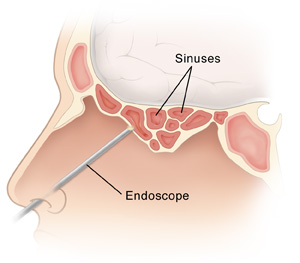Sinuses are hollow chambers formed by the bones of the face and head. Problems in the nose or sinuses can cause trouble breathing through the nose. They can cause pain and drainage from the nose. Or they can cause a loss in the sense of smell. Nasal endoscopy is a procedure that looks inside the nose and sinuses. It is often done by an ear, nose, and throat specialist called an otolaryngologist. It can help find the cause of your symptoms. It can also diagnose infections and help find structural problems in the nose. The procedure is done with a rigid or flexible endoscope. This is a thin, lighted tube with a small camera on it.
Preparing for the procedure
Prepare for the procedure as you have been told. Tell your health care provider about all medicines you take. This includes over-the-counter medicines, vitamins, herbs, and supplements. You may need to stop taking some of these before the procedure. Your provider will let you know.
The day of the procedure
The procedure is often done in an outpatient clinic. It takes
-
You may sit with a headrest supporting your head. Or you may lie down.
-
Once the nose is numb, the endoscope is carefully placed into the nose through a nostril.
-
The endoscope is guided through the passageways in the nose until it reaches the opening of the sinuses. As it moves, it gives the provider a clear view or picture of any problems.
-
The provider may take tissue samples (biopsies) if needed.
-
During the procedure, polyps, mucus, foreign objects, blockages, or other masses can be taken out with the endoscope.
-
When the procedure is done, the endoscope is gently taken out.
-
Gauze may be put into the nose to control any bleeding.
After the procedure
Your provider may talk with you about the results before you go home. Or you may schedule a follow-up visit to discuss results and treatment choices. After endoscopy, you can often return to your normal routine right away. Follow any directions you have been given. To soothe nasal passages, you may be advised to rinse your nose with saltwater. If so, your provider will explain how to do this. Call your provider if you have any severe nosebleeds over the next few days.
Follow-up
You'll likely see your provider for a follow-up visit. Depending on the results of the endoscopy, more tests may be scheduled.
Risks and possible complications
The risks of this procedure include:
-
Discomfort during the procedure.
-
Bleeding from the nose during or after the procedure.


